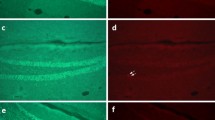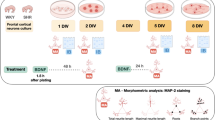Absract
Frequently, healthy individuals, children, and students are using stimulants to treat attention deficit hyperactivity disorder (ADHD)-like symptoms or to enhance cognitive capacity, attention and concentration. Methylphenidate, the most common treatment for ADHD, similarly to cocaine, blocks the dopamine reuptake, leading to increase in dopamine level in the synaptic cleft. Brain-derived neurotrophic factor (BDNF) and other neuroplasticity-relevant proteins have a major role in cellular plasticity during development and maturation of the brain. Young Sprague Dawley rats (postnatal days (PND) 14) were treated chronically with either cocaine or methylphenidate. The rats were examined behaviorally and biochemically at several time points (PND 35, 56, 70, and 90). We found age-dependent, but stimulant-independent, alterations in the mRNA expression levels of microtubule-associated protein tau, doublecortin, and synaptophysin. The PND 90 rats, treated with methylphenidate at an early age, exhibited increased BDNF protein levels in the prefrontal cortex compared to the saline-treated group. Despite the treatment effects at the biochemical level, cocaine and methylphenidate treatments at an early age had only minor effects on the behavioral parameters measured at older ages. The biochemical alterations may reflect neuroprotective or neuroplastic effects of chronic methylphenidate treatment at an early age.



Similar content being viewed by others
References
Algahim MF, Yang PB, Burau KD, Swann AC, Dafny N (2010) Repetitive ritalin treatment modulates the diurnal activity pattern of young SD male rats. Cent Nerv Syst Agents Med Chem 10:247–257
Andersen SL, Sonntag KC (2014) Juvenile methylphenidate reduces prefrontal cortex plasticity via D3 receptor and BDNF in adulthood. Front Synaptic Neurosci 6:1
Askenasy EP, Taber KH, Yang PB, Dafny N (2007) Methylphenidate (Ritalin): behavioral studies in the rat. Int J Neurosci 117:757–794
Avila J, de Barreda EG, Fuster-Matanzo A, Simon D, Llorens-Martin M, Engel T, Lucas JJ, Diaz-Hernandez M, Hernandez F (2012) Looking for novel functions of tau. Biochem Soc Trans 40:653–655
Banerjee PS, Aston J, Khundakar AA, Zetterstrom TS (2009) Differential regulation of psychostimulant-induced gene expression of brain derived neurotrophic factor and the immediate-early gene Arc in the juvenile and adult brain. Eur J Neurosci 29:465–476
Bevins RA, Besheer J (2006) Object recognition in rats and mice: a one-trial non-matching-to-sample learning task to study ‘recognition memory’. Nat Protoc 1:1306–1311
Bruchmuller K, Margraf J, Schneider S (2012) Is ADHD diagnosed in accord with diagnostic criteria? Overdiagnosis and influence of client gender on diagnosis. J Consult Clin Psychol 80:128–138
Carmack SA, Block CL, Howell KK, Anagnostaras SG (2014) Methylphenidate enhances acquisition and retention of spatial memory. Neurosci Lett 567:45–50
Carrey N, McFadyen MP, Brown RE (2000) Effects of subchronic methylphenidate hydrochloride administration on the locomotor and exploratory behavior of prepubertal mice. J Child Adolesc Psychopharmacol 10:277–286
Castellanos FX, Giedd JN, Marsh WL, Hamburger SD, Vaituzis AC, Dickstein DP, Sarfatti SE, Vauss YC, Snell JW, Lange N, Kaysen D, Krain AL, Ritchie GF, Rajapakse JC, Rapoport JL (1996) Quantitative brain magnetic resonance imaging in attention-deficit hyperactivity disorder. Arch Gen Psychiatry 53:607–616
Chase T, Carrey N, Soo E, Wilkinson M (2007) Methylphenidate regulates activity regulated cytoskeletal associated but not brain-derived neurotrophic factor gene expression in the developing rat striatum. Neuroscience 144:969–984
Chilakamarri JK, Filkowski MM, Ghaemi SN (2011) Misdiagnosis of bipolar disorder in children and adolescents: a comparison with ADHD and major depressive disorder. Ann Clin Psychiatry 23:25–29
Chomczynski P (1993) A reagent for the single-step simultaneous isolation of RNA, DNA and proteins from cell and tissue samples. Biotechniques 15(532–534):536–537
Chomczynski P, Sacchi N (1987) Single-step method of RNA isolation by acid guanidinium thiocyanate-phenol-chloroform extraction. Anal Biochem 162:156–159
Damianopoulos EN, Carey RJ (1992) Conditioning, habituation and behavioral reorganization factors in chronic cocaine effects. Behav Brain Res 49:149–157
Deacon RM (2006) Housing, husbandry and handling of rodents for behavioral experiments. Nat Protoc 1:936–946
Del Olmo N, Higuera-Matas A, Miguens M, Garcia-Lecumberri C, Borcel E, Solis JM, Ambrosio E (2006) Hippocampal synaptic plasticity and water maze learning in cocaine self-administered rats. Ann N Y Acad Sci 1074:427–437
Drechsel DN, Hyman AA, Cobb MH, Kirschner MW (1992) Modulation of the dynamic instability of tubulin assembly by the microtubule-associated protein tau. Mol Biol Cell 3:1141–1154
Eshkind LG, Leube RE (1995) Mice lacking synaptophysin reproduce and form typical synaptic vesicles. Cell Tissue Res 282:423–433
Findling RL (2008) Evolution of the treatment of attention-deficit/hyperactivity disorder in children: a review. Clin Ther 30:942–957
Fone KC, Nutt DJ (2005) Stimulants: use and abuse in the treatment of attention deficit hyperactivity disorder. Curr Opin Pharmacol 5:87–93
Friedman A, Frankel M, Flaumenhaft Y, Merenlender A, Pinhasov A, Feder Y, Taler M, Gil-Ad I, Abeles M, Yadid G (2009) Programmed acute electrical stimulation of ventral tegmental area alleviates depressive-like behavior. Neuropsychopharmacology 34:1057–1066
Fumagalli F, Cattaneo A, Caffino L, Ibba M, Racagni G, Carboni E, Gennarelli M, Riva MA (2010) Sub-chronic exposure to atomoxetine up-regulates BDNF expression and signalling in the brain of adolescent spontaneously hypertensive rats: comparison with methylphenidate. Pharmacol Res 62:523–529
Fumagalli F, Di Pasquale L, Caffino L, Racagni G, Riva MA (2007) Repeated exposure to cocaine differently modulates BDNF mRNA and protein levels in rat striatum and prefrontal cortex. Eur J Neurosci 26:2756–2763
Giannotti G, Caffino L, Calabrese F, Racagni G, Riva MA, Fumagalli F (2014) Prolonged abstinence from developmental cocaine exposure dysregulates BDNF and its signaling network in the medial prefrontal cortex of adult rats. Int J Neuropsychopharmacol 17:625–634
Gleeson JG, Lin PT, Flanagan LA, Walsh CA (1999) Doublecortin is a microtubule-associated protein and is expressed widely by migrating neurons. Neuron 23:257–271
Gomes KM, Souza RP, Valvassori SS, Reus GZ, Inacio CG, Martins MR, Comim CM, Quevedo J (2009) Chronic methylphenidate-effects over circadian cycle of young and adult rats submitted to open-field and object recognition tests. Curr Neurovasc Res 6:259–266
Guo T, Yang C, Guo L, Liu K (2012) A comparative study of the effects of ABT-418 and methylphenidate on spatial memory in an animal model of ADHD. Neurosci Lett 528:11–15
Heyser CJ, McNaughton CH, Vishnevetsky D, Fienberg AA (2013) Methylphenidate restores novel object recognition in DARPP-32 knockout mice. Behav Brain Res 253:266–273
Heyser CJ, Pelletier M, Ferris JS (2004) The effects of methylphenidate on novel object exploration in weanling and periadolescent rats. Ann N Y Acad Sci 1021:465–469
Howell LL, Negus SS (2014) Monoamine transporter inhibitors and substrates as treatments for stimulant abuse. Adv Pharmacol 69:129–176
Huttner WB, Schmidt A (2000) Lipids, lipid modification and lipid-protein interaction in membrane budding and fission—insights from the roles of endophilin A1 and synaptophysin in synaptic vesicle endocytosis. Curr Opin Neurobiol 10:543–551
Jones Z, Dafny N (2013) Dose response effect of methylphenidate on ventral tegmental area neurons and animal behavior. Brain Res Bull 96:86–92
Jones Z, Dafny N (2014) Acute and chronic dose-response effect of methylphenidate on ventral tegmental area neurons correlated with animal behavior. J Neural Transm 121:327–345
Kawauchi T, Hoshino M (2008) Molecular pathways regulating cytoskeletal organization and morphological changes in migrating neurons. Dev Neurosci 30:36–46
Kishi T, Matsuda Y, Iwata N, Correll CU (2013) Antipsychotics for cocaine or psychostimulant dependence: systematic review and meta-analysis of randomized, placebo-controlled trials. J Clin Psychiatry 74:e1169–e1180
Kuczenski R, Segal DS (2005) Stimulant actions in rodents: implications for attention-deficit/hyperactivity disorder treatment and potential substance abuse. Biol Psychiatry 57:1391–1396
Li X, DeJoseph MR, Urban JH, Bahi A, Dreyer JL, Meredith GE, Ford KA, Ferrario CR, Loweth JA, Wolf ME (2013) Different roles of BDNF in nucleus accumbens core versus shell during the incubation of cue-induced cocaine craving and its long-term maintenance. J Neurosci 33:1130–1142
Linssen AM, Sambeth A, Vuurman EF, Riedel WJ (2014) Cognitive effects of methylphenidate in healthy volunteers: a review of single dose studies. Int J Neuropsychopharmacol 17:961–977
Lu B, Martinowich K (2008) Cell biology of BDNF and its relevance to schizophrenia. Novartis Found Symp 289:119–129 discussion 129–135, 193–115
Maher B (2008) Poll results: look who’s doping. Nature 452:674–675
Maier, L.J., Liechti, M.E., Herzig, F. & Schaub, M.P. (2013) To dope or not to dope: neuroenhancement with prescription drugs and drugs of abuse among Swiss university students. PLoS One, 8, e77967.
Martinowich K, Lu B (2008) Interaction between BDNF and serotonin: role in mood disorders. Neuropsychopharmacology 33:73–83
McMahon HT, Bolshakov VY, Janz R, Hammer RE, Siegelbaum SA, Sudhof TC (1996) Synaptophysin, a major synaptic vesicle protein, is not essential for neurotransmitter release. Proc Natl Acad Sci U S A 93:4760–4764
Morley CP (2010) Disparities in ADHD assessment, diagnosis, and treatment. Int J Psychiatry Med 40:383–389
Nibuya M, Morinobu S, Duman RS (1995) Regulation of BDNF and trkB mRNA in rat brain by chronic electroconvulsive seizure and antidepressant drug treatments. J Neurosci 15:7539–7547
Normann C, Berger M (2008) Neuroenhancement: status quo and perspectives. Eur Arch Psychiatry Clin Neurosci 258(Suppl 5):110–114
Pierce RC, Pierce-Bancroft AF, Prasad BM (1999) Neurotrophin-3 contributes to the initiation of behavioral sensitization to cocaine by activating the Ras/mitogen-activated protein kinase signal transduction cascade. J Neurosci 19:8685–8695
Quintero GC (2013) Role of nucleus accumbens glutamatergic plasticity in drug addiction. Neuropsychiatr Dis Treat 9:1499–1512
Scherer EB, da Cunha MJ, Matte C, Schmitz F, Netto CA, Wyse AT (2010) Methylphenidate affects memory, brain-derived neurotrophic factor immunocontent and brain acetylcholinesterase activity in the rat. Neurobiol Learn Mem 94:247–253
Schmidt HD, McGinty JF, West AE, Sadri-Vakili G (2013) Epigenetics and psychostimulant addiction. Cold Spring Harb Perspect Med 3:a012047
Schwartz K, Nachman R, Yossifoff M, Sapir R, Weizman A, Rehavi M (2007) Cocaine, but not amphetamine, short term treatment elevates the density of rat brain vesicular monoamine transporter 2. J Neural Transm 114:427–430
Simchon Y, Weizman A, Rehavi M (2010) The effect of chronic methylphenidate administration on presynaptic dopaminergic parameters in a rat model for ADHD. Eur Neuropsychopharmacol 20:714–720
Spalletta G, Pasini A, Pau F, Guido G, Menghini L, Caltagirone C (2001) Prefrontal blood flow dysregulation in drug naive ADHD children without structural abnormalities. J Neural Transm 108:1203–1216
Tang A, Wanchoo SJ, Swann AC, Dafny N (2009) Psychostimulant treatment for ADHD is modulated by prefrontal cortex manipulation. Brain Res Bull 80:353–358
Teter CJ, Falone AE, Cranford JA, Boyd CJ, McCabe SE (2010) Nonmedical use of prescription stimulants and depressed mood among college students: frequency and routes of administration. J Subst Abus Treat 38:292–298
Thiel G (1993) Synapsin I, synapsin II, and synaptophysin: marker proteins of synaptic vesicles. Brain Pathol 3:87–95
Thiele C, Hannah MJ, Fahrenholz F, Huttner WB (2000) Cholesterol binds to synaptophysin and is required for biogenesis of synaptic vesicles. Nat Cell Biol 2:42–49
Volkow ND, Ding YS, Fowler JS, Wang GJ, Logan J, Gatley JS, Dewey S, Ashby C, Liebermann J, Hitzemann R, et al (1995) Is methylphenidate like cocaine? Studies on their pharmacokinetics and distribution in the human brain. Arch Gen Psychiatry 52:456–463
Volkow ND, Fowler JS, Wang GJ, Swanson JM (2004) Dopamine in drug abuse and addiction: results from imaging studies and treatment implications. Mol Psychiatry 9:557–569
Vorhees CV, Williams MT (2006) Morris water maze: procedures for assessing spatial and related forms of learning and memory. Nat Protoc 1:848–858
Warren BL, Iniguez SD, Alcantara LF, Wright KN, Parise EM, Weakley SK, Bolanos-Guzman CA (2011) Juvenile administration of concomitant methylphenidate and fluoxetine alters behavioral reactivity to reward- and mood-related stimuli and disrupts ventral tegmental area gene expression in adulthood. J Neurosci 31:10347–10358
Willcutt EG (2012) The prevalence of DSM-IV attention-deficit/hyperactivity disorder: a meta-analytic review. Neurotherapeutics 9:490–499
Yang PB, Swann AC, Dafny N (2006) Acute and chronic methylphenidate dose-response assessment on three adolescent male rat strains. Brain Res Bull 71:301–310
Yano M, Steiner H (2007) Methylphenidate and cocaine: the same effects on gene regulation? Trends Pharmacol Sci 28:588–596
Zubrycki EM, Giordano M, Sanberg PR (1990) The effects of cocaine on multivariate locomotor behavior and defecation. Behav Brain Res 36:155–159
Author information
Authors and Affiliations
Corresponding author
Rights and permissions
About this article
Cite this article
Simchon Tenenbaum, Y., Weizman, A. & Rehavi, M. The Impact of Chronic Early Administration of Psychostimulants on Brain Expression of BDNF and Other Neuroplasticity-Relevant Proteins. J Mol Neurosci 57, 231–242 (2015). https://doi.org/10.1007/s12031-015-0611-9
Received:
Accepted:
Published:
Issue Date:
DOI: https://doi.org/10.1007/s12031-015-0611-9




